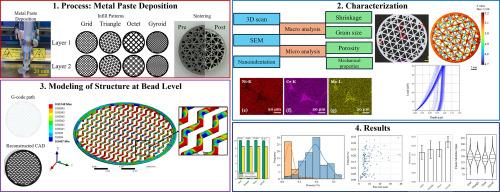填充结构对膏体挤压3D打印不锈钢收缩、微观结构和力学性能的影响
IF 2.9
Q2 MATERIALS SCIENCE, MULTIDISCIPLINARY
引用次数: 0
摘要
金属膏体沉积是一种新兴的增材制造方法,它将金属膏体挤出形成绿色部件,然后将其烧结致密化。研究了填充方式对316l不锈钢烧结件宏观组织和微观组织性能的影响。在多个表面和区域进行了全面的实验表征,包括孔隙度分析、晶粒尺寸测量、相识别、3D扫描和纳米硬度测试。结果表明,孔隙度和弹性模量随充填体几何形状和局部位置的变化而变化。晶粒尺寸在所有模式和位置保持一致,平均为~ 50µm。纳米压痕测量显示,316 L不锈钢的硬度值保持在预期范围内(2.6-4.5 GPa),不同区域的差异最小。孔隙以圆形为主,圆度值在0.96 ~ 0.99之间,表明表面能驱动致密化效果显著。在所有测试的图案中,“网格”填充图案由于增加了头重叠,实现了最高的密度和刚度。利用G-code重构的几何图形进行的颗粒级有限元模拟,捕获了局部收缩、孔隙演化和晶粒生长趋势,结果与实验结果吻合良好。这些结果验证了仿真框架,突出了填充设计在优化零件性能和可靠性方面的重要性。这里报告的所有结果都是针对在50%标称填充密度下制造的零件,并在所研究的烧结条件下加工(12小时循环,在1380°C下保持4小时)。本文章由计算机程序翻译,如有差异,请以英文原文为准。

Influence of infill architecture on shrinkage, microstructure, and mechanical properties in paste extrusion 3D printed stainless steel
Metal Paste Deposition is an emerging additive manufacturing method that extrudes metal paste to form green parts, which are subsequently sintered for densification. This study investigates the influence of infill pattern on the macro- and microstructural properties of sintered 316 L stainless steel parts. Comprehensive experimental characterization, including porosity analysis, grain size measurement, phase identification, 3D scanning, and nanohardness testing, was conducted across multiple surfaces and regions. Results revealed that porosity and elastic modulus varied with both infill geometry and local position. Grain size remained consistent across all patterns and locations, averaging ∼50 µm. Nanoindentation measurements revealed that hardness values remained within the expected range for 316 L stainless steel (2.6–4.5 GPa), showing minimal variation across different regions. Pores were predominantly circular, with circularity values ranging from 0.96 to 0.99, suggesting effective surface-energy-driven densification. Among all tested patterns, the “grid” infill pattern achieved the highest densification and stiffness due to increased bead overlap. A bead-level finite element simulation, using reconstructed geometries from G-code, captured localized shrinkage, porosity evolution, and grain growth trends, showing good agreement with experiments. These results validate the simulation framework and highlight the importance of infill design in optimizing part performance and reliability. All findings reported here are specific to parts fabricated at 50% nominal infill density and processed under the studied sintering conditions (12 h cycle with 4 h hold at 1380°C).
求助全文
通过发布文献求助,成功后即可免费获取论文全文。
去求助
来源期刊

Materialia
MATERIALS SCIENCE, MULTIDISCIPLINARY-
CiteScore
6.40
自引率
2.90%
发文量
345
审稿时长
36 days
期刊介绍:
Materialia is a multidisciplinary journal of materials science and engineering that publishes original peer-reviewed research articles. Articles in Materialia advance the understanding of the relationship between processing, structure, property, and function of materials.
Materialia publishes full-length research articles, review articles, and letters (short communications). In addition to receiving direct submissions, Materialia also accepts transfers from Acta Materialia, Inc. partner journals. Materialia offers authors the choice to publish on an open access model (with author fee), or on a subscription model (with no author fee).
 求助内容:
求助内容: 应助结果提醒方式:
应助结果提醒方式:


